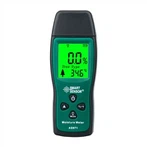The structure of the electronic distance meter
There are many kinds of electronic range finders, such as: handheld range finder, laser range finder, ultrasonic range finder, infrared range finder, introduce several of them; optical range finder, the English full name is "Optical Range Finder". It can be literally translated as "range measuring instrument", which is an instrument that uses the concept of trigonometric functions to measure distance. Although its concept was proposed in the 18th century, it was difficult to realize it due to the backward optical lens processing technology at that time.
Total stations can be used in almost all surveying fields. The electronic total station is composed of a power supply part, an angle measurement system, a distance measurement system, a data processing part, a communication interface, a display screen, and a keyboard.
Compared with the electronic theodolite and the optical theodolite, the total station adds many special components, so that the total station has more functions than other angle-measuring and distance-measuring instruments, and is more convenient to use. These special components constitute the unique characteristics of the total station in terms of structure.
1. coaxial telescope
The telescope of the total station realizes the coaxiality of the collimation axis, the emitting and receiving optical axes of the ranging light wave. The basic principle of coaxialization is: install a beam splitting prism system between the telescopic objective lens and the focusing lens, and realize the multi-function of the telescope through this system, that is, aim at the target, make it image on the reticle, and measure the angle. At the same time, the external optical path system of the distance measuring part can make the modulated infrared light emitted by the photosensitive diode of the distance measuring part reflect back through the same path after being shot to the reflective prism through the objective lens, and then the returned light is received by the photodiode through the action of the dichroic prism ;In order to measure the distance, it is necessary to set up an inner optical path system inside the instrument. The modulated infrared light emitted by the photosensitive diode is transmitted to the photodiode for reception through the optical fiber in the beam splitting prism system, and the phase of the light is modulated by the inner and outer optical paths. The difference indirectly calculates the travel time of light and calculates the measured distance.
The coaxiality allows the telescope to realize the measurement function of measuring all basic measurement elements such as horizontal angle, vertical angle and oblique distance at the same time. Coupled with the powerful and convenient data processing function of the total station, the total station is extremely convenient to use.
2. Biaxial automatic compensation
The principle of dual-axis automatic compensation has been introduced in the inspection and calibration of the instrument. If the longitudinal axis of the total station is tilted during operation, it will cause angle observation errors, which cannot be offset by centering the observation values of F1 and F2. The unique dual-axis (or single-axis) tilt automatic compensation system of the total station can monitor the tilt of the longitudinal axis, and automatically correct the angle measurement error caused by the tilt of the vertical axis in the reading of the dial (some total The maximum inclination of the longitudinal axis of the station instrument is allowed to ±6'). , the angle error caused by the tilt of the vertical axis can also be automatically calculated by the microprocessor according to the correction formula of the vertical axis tilt, and added to the reading of the dial to correct it, so that the reading displayed on the dial is the correct value, that is, the so-called vertical axis tilt Automatic compensation.
3. the keyboard
The keyboard is the hardware for the total station to input operation instructions or data during measurement. The keyboard and display screen of the total station instrument are both double-sided, which is convenient for operation during forward and reverse mirror operations.
4. memory
The function of the memory of the total station is to store the measurement data collected in real time, and then transmit them to other devices such as computers for further processing or utilization. The memory of the total station has two types: internal memory and memory card.
The internal memory of the total station is equivalent to the internal memory (RAM) of the computer, and the memory card is an external storage medium, also known as PC card, which is equivalent to the disk of the computer.
5. Communication Interface
The total station can input the data stored in the memory into the computer through the BS-232C communication interface and communication cable, or transmit the data and information in the computer to the total station through the communication cable to realize two-way information transmission.






